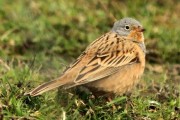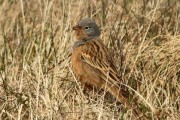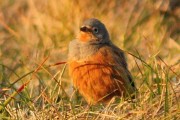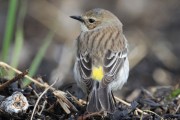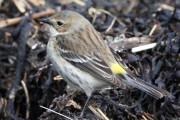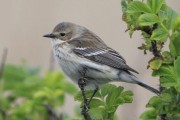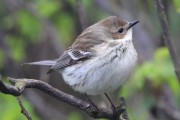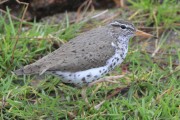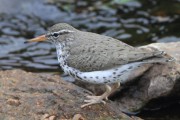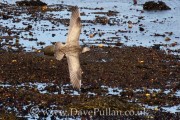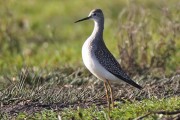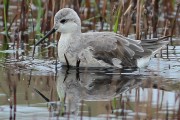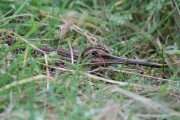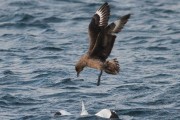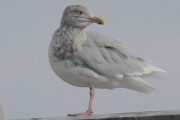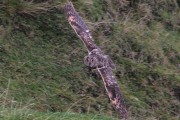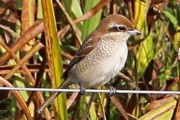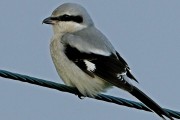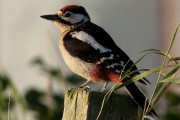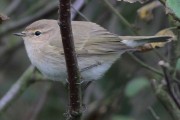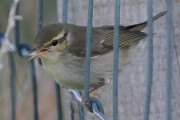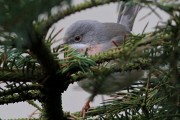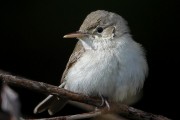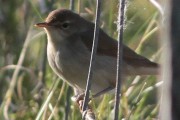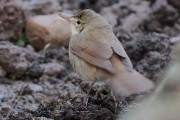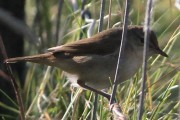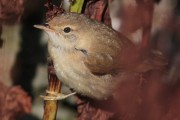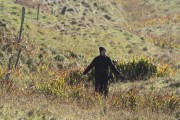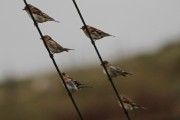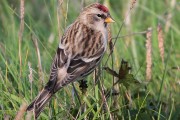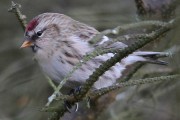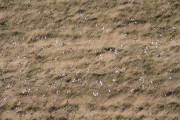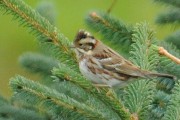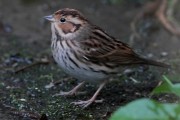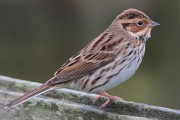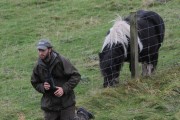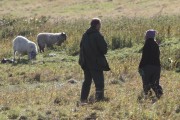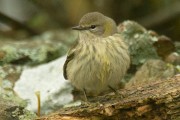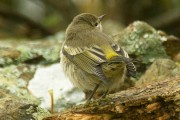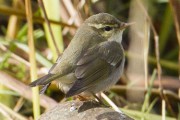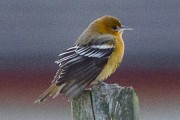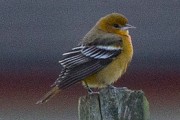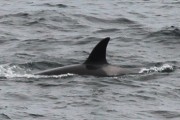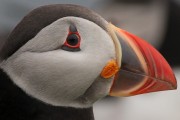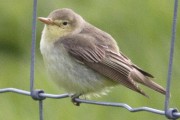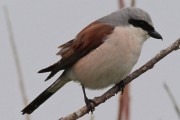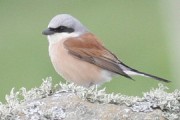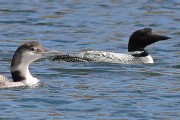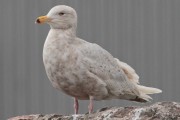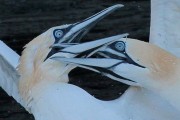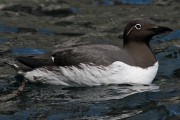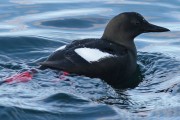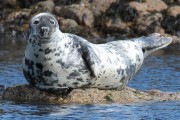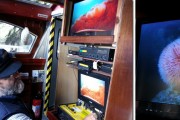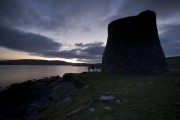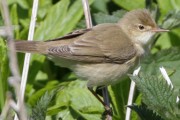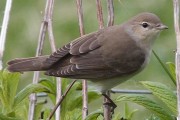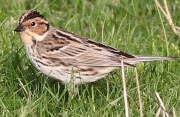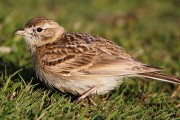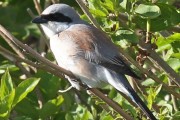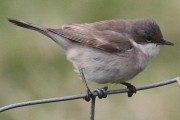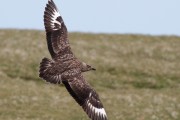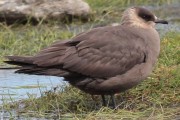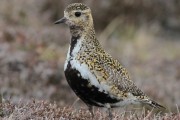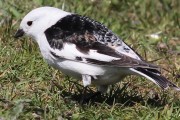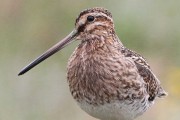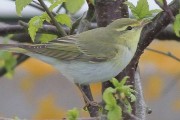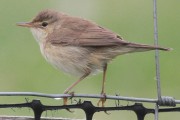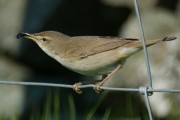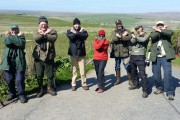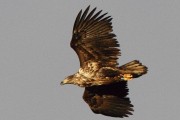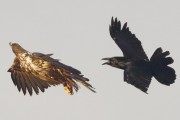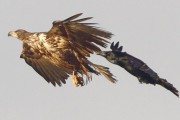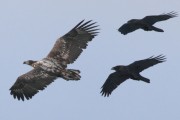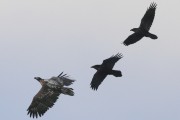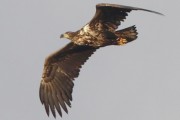Archive for the ‘Birding in Shetland’ Category:
Cretzschmar’s Bunting, Burkle, Fair Isle 27th April 2014
Posted by Deryk Shaw on Wednesday 21st May 2014 | Birding in Shetland
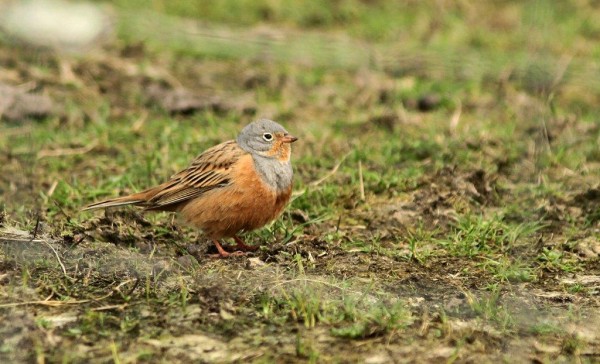
Sunday 27th April was the most beautiful day – blue skies, sunshine, a light south-easterly wind and at 12ºc, the warmest day of the year so far! Perfect for going birding! However, as part of my post-Observatory life, I run a croft and days like these are so few and far between at this time of year on Fair Isle I decided I should really take advantage and do some croft work….
So, it was about 11.30 am and I was in the midst of dosing and feet-trimming my year-old sheep when David Parnaby (the current Observatory Warden) texted me to say there was a female type Red-breasted Flycatcher on the fence at Burkle (my house). That’s great – a garden tick! I returned home just before 1pm to see David and a group of Obs staff lying in the grass just across the road from my garden. I scanned the fence-line where they were looking with camera and bins and spotted the RbF. Excellent!
I went inside for lunch and added species number 151 to the list on the kitchen wall!! Twenty minutes later, I headed back out with my ten year-old son Ythan and my camera to see if we could see it again. It was still present on the fence so we ventured down to where the Obs crew had been ‘sunbathing’ and waited for it to come a bit closer, which it duly did. After a few minutes watching, Ythan headed back into the house and I continued to watch the flycatcher. I had only taken one photo and was just trying to view the uppertail through my bins when in the rough grass below the fence an orange-breasted bird with a grey head hopped briefly into view and disappeared again.
The view I had was long enough for me to suspect a male Ortolan. Nice! It appeared again a few moments later and I was pleased to see that it was indeed an orange-breasted bunting with a blue-grey head, however I was gobsmacked to see that instead of a nice creamy-yellow throat and submoustachial stripe (of an Ortolan) these were reddish-brown!!! I was watching a Cretzschmar’s Bunting!!! Wow!!!! My heart was racing now. I took a couple of quick record shots, in case it scarpered, then phoned the Obs – interrupting yet another famous FIBO Sunday lunch!! Next, I phoned the house and told Ythan to ‘come back down – quickly – and bring your bird book’.
I took a mental note of the plumage details; blue-grey head, lateral throat stripe and breast with a clear demarcation to rusty orange underparts, stout dirty pink bill, white eyering, broad rusty brown tertial edges, pink legs……. Ythan duly arrived and I was delighted to show him my find – just a fifth for Britain, but the third for Fair Isle. He was (nearly) as excited as I was – and whilst it was out of view – he looked it up in his book and I pointed out the distinguishing features.
The bird reappeared and I set about taking photos. It hopped along in the rough grass below the fence, then ventured onto the road verge. I heard a vehicle coming along the road so asked Ythan to stop the car as it came round the corner whilst I continued to try and get some photos. The bird hopped across the road and onto Burkle land – Yes! No. 152! Ythan explained to the two local car owners the reason for the traffic stoppage. Fair Islanders are quite used to being stopped for a bird and are always keen to see the latest cause for commotion – many of them have seen a list of birds that would make the most ardent of twitchers weep!
Unfortunately, the bird had other ideas and suddenly got up, flew across my lawn, past the birdtable and seemed to come down on the far side of the garden. However, by the time we got there it had vanished. The Obs van arrived but all I could show them were my photos!! Suitably gripped and as more people arrived the search began. However, despite a thorough search of the south of the isle right up until dusk, the only thing to be found was a Caspian Stonechat – another fifth for Britain and a stunning-looking consolation nevertheless!! Incidentally, this became species number 153 on the Burkle list a couple of days later!!
Fortunately, the bunting was rediscovered the following day and is still present as I write (Wed 30th) – so far two planeloads of twitchers from south are very happy!!
This is the fifth record for Britain following the first two British records on Fair Isle (10th-20th June 1967 & 9th-10th June 1979), the third on Stronsay (14th-18th May 1998) and most recently the only autumn record on North Ronaldsay (19th-21st September 2008). So currently, the scores are Fair Isle 3 – Orkney 2. All hail the magic isle!
Deryk Shaw
Permalink
Yellow-rumped Warbler at Haroldswick, Unst May 7th/8th 2014
Posted by Brydon Thomason on Friday 16th May 2014 | Birding in Shetland
Unst resident birder and team member Robbie Brookes shares his exciting discovery of the Unst Yellow-rumped Warbler, which remarkably was proven to be the Orkney bird, found just 24 hours before. His luck didn’t stop there though – just hours later he scored with a Subalpine Warbler while trying to relocate the Yellow-rumped – And as if this was not enough, within a week on the 15th he added Spotted Sandpiper to his spring rarity finding spree! Nice work, keep it up Robbie…
Around 9.30am on the 7th May 2014, I decided to take a drive up the north of the island to look for migrants as we’d been having quite a spell of south easterlies. My first stop was going to be Haroldswick Pools which had been particularly good for some of the commoner migrants over the preceding weeks (Blackcaps, Chiffchaffs, Brambling etc and also Wryneck and a Hawfinch). Unfortunately as I drove down the hill I could see a small vehicle parked there, so I decided to go further north and check Skaw, Lamba Ness and Norwick first.
Returning back to the pools some time after 11am, I pulled up and within a minute or so, I noticed a small bird at the far end of the Rosa which was facing me with its head slightly turned. It seemed to have quite a pale breast, slightly streaked with a contrasting dark head. I had a feeling it wasn’t anything I’d come across before; so, doing what I always do, I grabbed the camera and managed to fire off a few frames just in time before it dropped down in to the Rosa bushes. Checking the pictures on the back of the camera, I knew was something pretty unusual and had a ‘gut’ feeling it was an American warbler due to its overall ‘structure’. However, my experience of American passerines was limited to just two birds – a Red-eyed Vireo that was at Valyie on Unst in September 2012 and the Cape May Warbler found by Mike Pennington in Baltasound in October 2013.
As I looked through my ‘Collins’ guide and also the ‘Sibley’ app on my iPod, I kept an eye on the bushes for the bird to re-appear; thankfully it did and I got to see its bright yellow rump. Time to ‘phone a friend’ I thought.
The first call was to Brydon Thomason at around lunchtime, who I knew was on the island. Brydon however, was out guiding an Otter Photography itinerary at that time and when we spoke could do little more than whisper as they were watching otters. He suggested I photographed the back of the camera screen with my phone and send him some pictures. This I did, but they just wouldn’t send – probably down to the image sizes and the pretty slow network that we have here. The next call was to Chris Rogers who was also birding around the north of Unst, all I got was his answerphone, so I left a message and hoped he got it. Last but not least, I emailed and texted Mike (Pennington) who I knew would be teaching at the school – maybe he would have time to come down at lunchtime? After what seemed like a long time, Chris pulled up. He was oblivious to what I thought I’d found as he’d not received my call (when he arrived, he took my excitement to be that I’d re-found the Wryneck !) He looked at the pictures and confirmed it was indeed a Yellow-rumped Warbler (plus a few expletives!).
Shortly after, Brydon arrived with his guests and then a while later, several other local birders from Mainland arrived. Most of the time, the bird only showed briefly when it came to the outside of the bushes to feed, before flitting back to cover. By mid-afternoon it hadn’t been seen for a while, so it was suggested to look around the village. I decided to drive up to a nearby croft cottage with a nice overgrown garden. I didn’t find the Y-r Warbler, but I did get a brief view of a Sub-alpine Warbler – too brief to get its race. I phoned Brydon again but we couldn’t relocate it. Thankfully it was re-found later by Brydon and Chris and eventually identified as a ‘western’.
By 5.45pm I had to return home to Baltasound, but a number of people continued to look for the bird, which then turned up back at the Rosa bushes around 7.45pm and was seen by a number of people.
The following morning I was up at 5am to go and see if the bird was still there. By 5.45am, I’d seen the bird and by 6am the news had been put out again by Brydon that it was still present. I then spent most of the morning watching and photographing the bird; on this day however, it was behaving differently. Instead of skulking around, it was now perching on the tops of the bushes, fly catching and even going down on the ground to feed in the open. I checked the bushes again the following morning but it had moved on.
I had seen that there had also been one on North Ronaldsay the day before, but I didn’t think for one minute that this could be the same bird. When I heard later that the pictures of the two sightings had been compared and it was confirmed it was indeed the same bird, it hit home how lucky it was for the bird to be re-found 130 miles away, let alone that it was me that found it.
Robbie Brookes, 15th May Baltasound Unst
Permalink
Shetland Autumn Birding Trip Report 2013
Posted by Martin Garner on Friday 20th December 2013 | Birding in Shetland
A ‘systematic style’ round up of this year’s Shetland Autumn Birding trips in late September and early October by Martin Garner…
The extremities of Britain are the Shetland Islands to the north and the Scilly Isles to the South. Both have been a magnet for birds and birders for many decades. Something’s changing though. Light-hearted banter goes on each year throughout the birding nation and amongst visitors to these exciting archipelago’s about which will see the greatest number of rarities. Hands down. Autumn 2013 saw Shetland run away with all the prizes. Whether it’s a shift in the jet stream, factors in the birds’ origins or reasons as yet unknown and once again the Shetland Nature team were well-positioned for a treasure trove of autumn birding.
An image gallery of some of the headline acts over the two weeks:
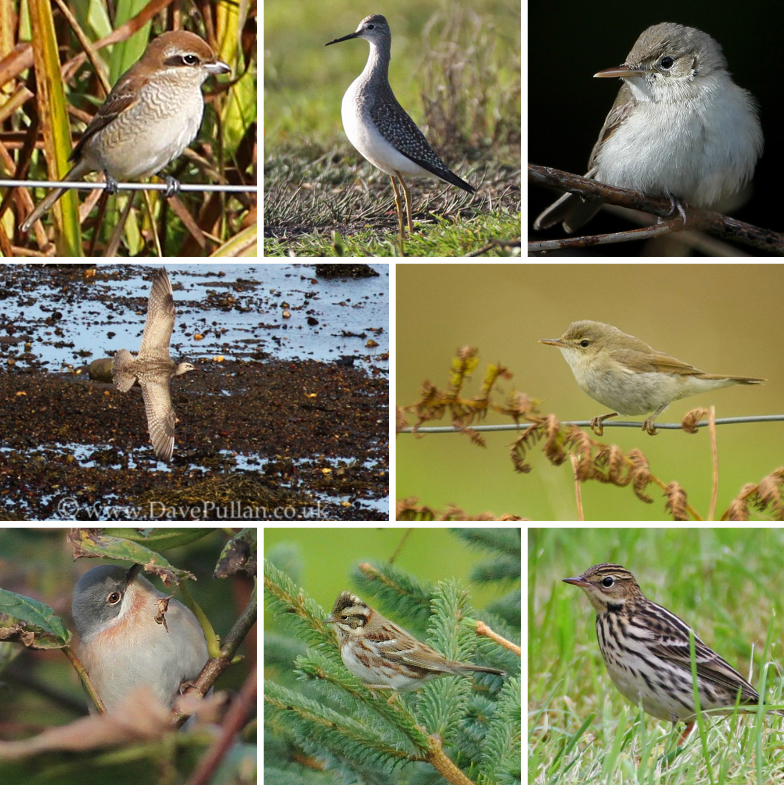
Row 1: Brown Shrike – Jim Nicolson; Lesser Yellowlegs – George Petrie; Eastern Olivaceous Warbler – Jim Nicolson.
Row 2: Hudsonian Whimbrel – Dave Pullan; Blyth’s Reed Warbler – Brydon Thomason.
Row 3: Eastern Subalpine Warbler – Martin Garner; Rustic Bunting – Andy Cook; Pechora Pipit – George Petrie.
Highlights and headlining events
Some of the notable events the Shetland Nature team got up to:
- Re-identifying an Eastern Subalpine Warbler with ground-breaking ID features
- Finding a Rustic Bunting
- The unexpected excitement of identifying a Blyth’s Reed Warbler which had been put out as a Marsh Warbler
- The surprise team ‘discovery’ of an Arctic Warbler
- Helping identify an Eastern Olivaceous Warbler
- Mega rarities; Hudsonian Whimbrel, Thick-billed Warbler, Eastern Olivacious Warbler, Brown Shrike
- Being first on sight to a just found Pechora Pipit (by Shetland Nature team member Roger Riddington)
- Watching a flock of over 2,000 Snow Buntings with a Merlin flying among them
- Finding the first Great Grey Shrike of autumn 2013 in Britain
- Record breaking arrival of Yellow-browed Warbler and one in the hand
We love our lists!
We scored a 100 species in the first week and 115 in the second week. Only 2 shy of our 2010 record of 117 species. Keeping a list during the week adds to our variety, a little competition and lots of fun…
Swans to Herons
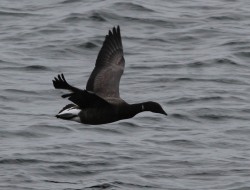 It’s always lovely to see the Whooper Swans both birds that have bred on Shetland and migrants from Iceland. Small flock of Pink Feet dropped in near the Lesser Yellowlegs. A female Pintail (scarce in Shetland) felt wild on Lamba Ness. A Dark-bellied Brent Goose found by a group member got an Unst local birder running. Eider rafts always provided a spectacle. Long-tailed Duck and Common Scoter were seen together several times. Both Red-throated and Great Northern Divers added sparkle to the day in late summer plumage.
It’s always lovely to see the Whooper Swans both birds that have bred on Shetland and migrants from Iceland. Small flock of Pink Feet dropped in near the Lesser Yellowlegs. A female Pintail (scarce in Shetland) felt wild on Lamba Ness. A Dark-bellied Brent Goose found by a group member got an Unst local birder running. Eider rafts always provided a spectacle. Long-tailed Duck and Common Scoter were seen together several times. Both Red-throated and Great Northern Divers added sparkle to the day in late summer plumage.
Gannets, whilst not rare, thoroughly entertained, plunge-diving and battling with Bonxies.
Grebes to Great Bustard
OK there were no Great Bustards :) Slavonian Grebes were found on little patches of water. Both Merlin and Peregrine encounters were special which likely included Icelandic Merlins. But the Unst Crane had sadly died by the time we got there.
Oystercatcher to Glaucous Gull
Golden Plover flocks were not rare but always beautiful but the Hudsonian Whimbrel stole the show on the wader front, followed closely by a young Lesser Yellowlegs and moulting adult Wilson’s Phalarope. Four types of three different species of cryptic snipe were enjoyed. Jack Snipe, Woodcock and both Common and very rusty Icelandic (faeroeensis) Snipes. Bonxies patrolled every day, Black Guillemots sported a variety of age and plumage types and scarcer Gulls included juvenile Little and adult Glaucous.
Rock Dove to Raven
Rock and Turtle Doves were studied for different reasons. The first for criteria compared with Feral Rock Doves, the second due to its increasing rarity in Britain. Migrant Long-eared and Short-eared Owls showed well and Shrikes were a highlight with a first winter Brown Shrike on the first morning, both Red-backed and Great Grey seen (the latter the first of the autumn in Britain). Rooks and migrant Scandinavian Jackdaws added value to our week-long list. Another northern speciality seen were Great-spotted Woodpeckers from Scandinavia.
Goldcrest to Wheatear
Here comes a group that never disappoints – warblers! Both Siberian Chiffchaffs and Common Chiffchaffs were available for comparison – this being the best place in Britain to see the eastern sub-rarities and a single Short-toed Lark fell into this category too. Overall warblers stole the show. Yellow-browed’s were everywhere with an amazing total over 150 on one day seen by Shetland Nature leaders on Unst and West Mainland. An Arctic Warbler was a great team find. The finer points of Siberian Lesser Whitethroat were studied on a couple of birds. New ID features were played out on an Eastern Subalpine Warbler and the biggest rarities attracting National attention were a Thick-billed and an Eastern Olivacious. We had great opportunity to study the ‘acros’ by finding and identifying Blyth’s Reed, Marsh and Reed Warblers. And to complete the set Brydon found a Paddyfield Warbler just after the holidays had ended. Early winter Thrushes, sparkling Scandinavian Robins, Red-breasted Flycatcher and two types of Wheatear filled out the chats.
House Sparrow to Baltimore Oriole
The only Yellow Wagtail seen was an interesting grey-headed type (thunbergi). The Shetland speciality, Pechora Pipit performed for us again and Finches brought colour every day with Chaffinch, Brambling, Crossbills, Common Rosefinch and Hawfinches. The Redpolls as ever challenged and entertained with Lesser, Mealy, a brief Coue’s Arctic, a tricky Hornemann’s and possible Icelandic Redpolls. Snow Buntings were simply spectacular, seemingly everywhere, everyday. But a flock of over 2000 on Fetlar said “Once in a life time”. A Rustic Bunting find for the team was a special moment. Point blank views of a smart male Little Bunting were enjoyed with no other birders, though Bydon’s Baltimore Oriole didn’t wait for us this time. Of course there’s always next year! Will you be joining us?
Read more about our Shetland Autumn Birding holiday »
Permalink
The Cape May Warbler at Baltasound – 23/10/13
Posted by Mike Pennington on Sunday 27th October 2013 | Birding in Shetland, News
(Intro by Brydon Thomason)
In a week that had already produced a sterling crop of rarities including Siberian Rubythroat, Isabelline Shrike, Lanceolated Warbler and Red-flanked Bluetail, it was clear that Shetland’s epic autumn was far from over…
Having enjoyed a ‘once in a blue moon’ meal with friends and overnight stay in town, Vaila and I had made it as far as Toft ferry, just over an hour away from home to Unst when I picked up a voicemail, it was Margaret Pennington; “Brydon, Mike wants you to come straight to the old Manse and to bring an American field guide…” To say my heart skipped a beat would be a massive understatement. For a birder of Mike’s calibre to ask for assistance and field guide was unusual to say the least, but an American one – this was huge, clearly this was going to be a day never to be forgotten!
I was just over an hour from arriving on Unst when Mike got through on the phone, informing me of his discovery, an American Wood warbler, the features he had (and hadn’t) seen and the species that were at that point in the short list. But one of the names mentioned especially urged my foot to press harder on the accelarator as I drove north – Cape May Warbler!
Mike shares his account of the epic discovery of the Cape May warbler, which had only reached Europe once before…
Brydon
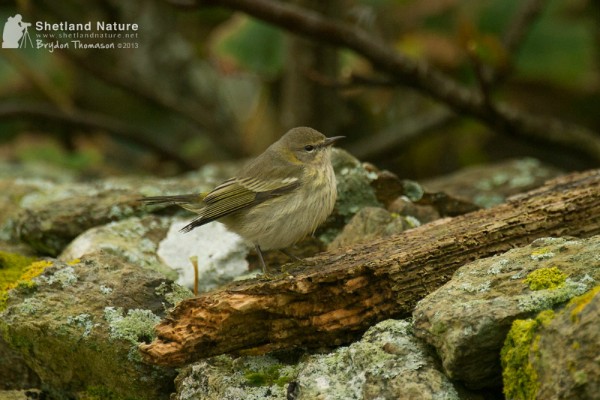
The biggest element in finding a rare bird is surely luck. Perseverance, local knowledge, experience, identification skills – they all play a part – but at the end of the day you have to be in the right spot at the right time when the bird’s showing. On 23rd October, after being away for a few days, I decided to walk round Baltasound rather than drive to the north end of Unst; I decided to head towards the school, instead of heading to Halligarth first as I would usually do; and after checking the lone tree in the Manse garden I stopped for a chat and glanced across to the lone tree again, and noticed a strange-looking bird which definitely required a closer look. Such was the chain of fortune that led to the discovery of a second for the Western Palearctic.
I was chatting to another local birder Dick Foyster, discussing the day’s obvious arrival of thrushes and Blackcaps, when I first saw the bird. From a distance the bird looked vaguely Phylloscopus-like, but it had a big pale patch on the wing. I suggested to Dick that we needed to have a closer look, so we strolled along the road towards the corner of the garden. The bird appeared again on the outside of the sycamore. Incredulously, I realised that this was something extremely interesting: “that’s an American wood warbler!” The bird was on view for a good 20 seconds or so, long enough to realise what we were looking at and take in the most obvious features. This was, however, my best view of the bird for the next four hours!
Over the next hour the bird showed fleetingly in the lone sycamore. Dick had to leave as he had people coming to do work at the house. My phone had no signal. My only attempts at taking a photo had captured some out of focus leaves. I could get very little more on the bird. Then it left the sycamore and headed to a small patch of nettles. By the time I got there, there was no sign of it. I returned to the sycamore – no sign. A bird flew past and I chased it – it was a Blackcap. Two more Blackcaps were chased down. It looked as though it had gone and I still had no photos and only a cursory description.
I’ve never been in this situation before, but faced with a Setophaga (they’re not Dendroica any more, remember), and one without obvious bright colours on it, my thoughts have always been start with Blackpoll Warbler and work from there. Some of the features seemed good for Blackpoll: streaked underparts, fairly plain face, two wing bars, pale tertial fringes, white undertail coverts, some white in the tail. But the wing bars seemed odd – from a distance they looked more like a pale wing patch, and only close up was it obvious that there were two bars. And wasn’t Blackpoll a brighter bird? This was a very dull greyish-olive bird. There was something of Yellow-rumped Warbler in the plain face and streakiness, but there seemed to be no obvious yellow in the plumage (I hadn’t seen the greenish rump or yellowish primary fringes at this stage). The bird did remind me of Cape May Warbler,which I had seen in Cuba. But surely not – I knew that there was only one British record and that was in spring. It seemed that I might have something really, really good, but I still didn’t have enough to be sure.
I decided to check the lone sycamore in the Manse garden once more before widening my search, and to my relief the bird had returned. This time I was determined to get photos as most views so far had been too brief to get any more detail than I already had. Eventually I grabbed a few poor photos in the worsening weather – it was definitely getting foggier all the time – before the bird left the sycamore and headed determinedly towards the old church at Hillside. The photos revealed one feature I had not yet seen in the field: a bright green neck patch.
At this point my wife Margaret arrived after Dick Foyster had phoned her. She brought two vital items – a copy of Sibley and a mobile phone on another network. I looked through the field guide. Could it be a really dull Blackpoll with dark legs? Check the other species. Nothing fits – except my long shot of Cape May Warbler – there was that greenish neck patch on a dull greyish-olive bird! This was a big, big call and I really, really wanted someone else to see it. I was pretty sure it had to be a Cape May Warbler, but it was massive leap of faith to actually believe it!
I phoned Brydon Thomason who was on his way back home to Unst but would not be back for over an hour. Then I phoned Paul Harvey and told him I had a Dendroica (yes, I know I should have said Setophaga). As Paul was Shetland year-listing I knew he’d come even if it was ‘only’ a Blackpoll, but I asked him how I would separate Blackpoll from Cape May Warbler. Mantle and leg colour were suggested. Dark legs and plain mantle pointed towards Cape May Warbler again! We decided to put out news on the local grapevine, without a definitive identification for the moment, to give people the chance to come for it. I decided to try and relocate the bird and stay with it until help arrived.
Margaret and I headed down to the old church at Hillside, where there is a small garden holding two or three sycamores. We saw the bird almost immediately, but it was as furtive as ever, mainly revealing itself when chasing off a Chiffchaff and a Blackcap that dared to enter the trees. Just before Brydon Thomason arrived, though, it started feeding off the walls around the small garden. This meant that Brydon got good views and more photos almost as soon as he got there. The bird even started calling in flight – a sharp tsip, almost reminiscent of Song Thrush or a rare bunting. Brydon had also brought a copy of Kaufman (which depicts a very dull Cape May Warbler) and he too went through the process of elimination via the field guides. Conclusion, it had to be a Cape May Warbler.
Now that it was conclusively identified the bird suddenly decided to stop hiding and started feeding along the wall behind the sycamores. Whereas I had never seen it perched in one place for more than a few seconds before, it now sat in full view on the wall. It was only now that I finally saw the bright greenish rump and the yellowish fringes to the remiges, but we could also see the greenish neck-patch, which was only visible at some angles, and the broad fringes to the greater coverts that produced the wing-panel that was so obvious at distance. Paul Harvey and a few other observers arrived soon afterwards, and about 20 or so people made it up from Mainland Shetland before dark. The next day more than 60 people saw the bird, with the highly novel sight of five aircraft parked on the apron at Baltasound airstrip.
It was only after it went dark on the first evening that the enormity of the find sank in. This was not just a second for Britain, but it was only the second for the whole of the Western Palearctic. This is a species that has not even turned up in the Azores. This is a species that has never been found in autumn anywhere on this side of the Atlantic, the previous British record involving a singing male in spring, found by Tom Byars and Iain McDonald in Paisley Glen, near Glasgow, on 17th June 1977. It may not be a first for Britain, surely every rarity-finders Holy Grail, but this was just as good in my eyes.
Finally, a thank you for the good-natured manner of the visiting birders and for following the advice put out via the Nature in Shetland website. Unst has not seen anything like this before and most residents actually enjoyed the novelty of the occasion. But there is a way of further showing your gratitude for the hospitality enjoyed by many birders in Shetland in recent years. We may not go around rattling a donations tin, but there is a modern alternative, and Shetland Bird Club has set up a Just Giving page to raise money for MacMillan Cancer Support at www.justgiving.com/Shetland-Bird-Club. So, if you twitched the Cape May Warbler, or the Pine Grosbeak, or the Thick-billed Warbler, if you came for a birding holiday, if you enjoyed a warm welcome, exemplified by the friendly sign at the Mid Yell Subalpine Warbler, please consider showing your gratitude by supporting this charity, which does sterling work in Shetland.
Mike Pennington
Permalink
The Baltimore Oriole – Baltasound, Unst, Shetland Islands – 19/09/13
Posted by Brydon Thomason on Friday 25th October 2013 | Birding in Shetland, Otters
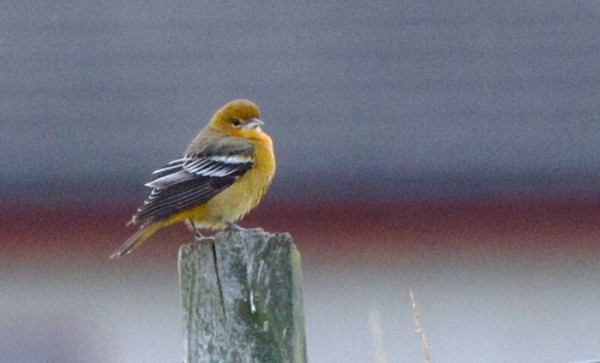
As working days go it had already been good; an early start with photographer Simon Hawkins (who had booked a bespoke one-to-one itinerary with me) to work on the sun rising over Muness had not only rewarded us with beautiful light and clear blue skies but also a fine Arctic Warbler, (the second one I’d found in under two weeks!) which had found shelter along a coastal patch of nettles and iris.
As is often the case when leading such trips I split the day and do a dawn start, finish up and meet again to stay out into sunset, when making this decision for this day however, I could never have imagined what good fortune it would bring. Dropping Simon off at our accommodation, The Shetland Nature Lodge and inspired by the Arctic Warbler I was keen to check my local patch Halligarth (one of Shetland’s largest Sycamore stands), right next door to our house and so hurried home to do so after arranging to meet again at 14:00hrs.
A few minutes later my thoughts of scoring another BB rarity had given way to hunger for bacon butties and caffeine. Walking the over grown lane, (dominated by Rosa Rugosa, Fucia and Hawthorn) towards the main garden it felt almost as if I was on auto pilot and simply going through the motions of my daily circuit when ‘SHIZAM!!’ – a large passerine flew out from cover just a meter or two from in front of me. The bird was completely unfamiliar as it flew from me but did perhaps give the impression of large a shrike, quite rufous and long tailed. It landed about 40-50 feet from me on the outside lower edge of the Sycomore canopy and as it did, quick as a flash- my Swarovski 10 x 42’s revealed what has to be one of the most glaringly gorgeous and ‘trouser-tearingly tremendous’ rarities I have had the fortune to find and I heard myself saying the words “IT’S A ‘FLIPPING’ NORTHERN ORIOLE!!!” – (note that there is a word in that quote I may have swapped for publishing purposes!).
Perhaps over and above its stunning flame orange plumage, blazing white wing bars and blue-grey legs and bill it was its loud and explosive tirade of chattered alarm which was a sound I will never forget! The first two or three seconds viewing felt as if it wasn’t real but as the words I had just said registered into reality and I came out of that slow motion ‘this cannot be’ moment , I began to shake and yes- that’s right, adrenalin took over! Gazing at it perched for what was only around seven to ten seconds, I realised I was without camera or phone but managed to marginally compose myself enough to just watch it, my heart pounding like an Olympic sprinter though I daren’t move a muscle!
Without warning it hopped onto another branch and then worked its way into the cover of the canopy and that was it- totally thunderstruck, I said the words again but this time almost shouting them through adrenalin fuelled jaws- “It’s a BALTIMORE ORIOLE!!” As by now I was composed enough to think of which was which. I ran to the house to phone the news out with my heart pounding.
The distance from the scene to our drive way is a mere 50 yards or so, which needless to say I did in Usain Bolt style but by the time I reached the phone my composure had gone, it was almost a struggle to breathe! A few phone calls later and within ten minutes, Robbie Brookes and Mike Pennington had joined me, during which time I didn’t dare make a move. Bizarrely, we worked the gardens without even as much as a glimpse- two hours later the first of the Shetland birders started to arrive but the extended coverage yielded nothing- it seemed as if my ten second glimpse was it until Paul ‘Duracell’ Harvey relocated it about half a mile away where once again – it wasn’t letting up easily and only four other observers scored, one of which was Ian Cowgill, to whom I will be forever thankful for nailing theses shots – nice work Ian!
Surprisingly the Baltasound Baltimore story did not end there however as it reappeared four days later on the 23rd when at last, it was seen by most birders who could make it, it was however still extremely elusive.
This was the 24th record of this North American species for Britain and third for Shetland but first since 1974 (which also arrived on the same date) and one on 26th September 1890, which was the first record for Britain.
After collecting Simon to resume our Photography workshop one to one for the afternoon, we headed off to work on Otters and enjoyed a wonderful two hour encounter with a mother and her two cubs (photographed below). All in all a pretty fine day indeed!
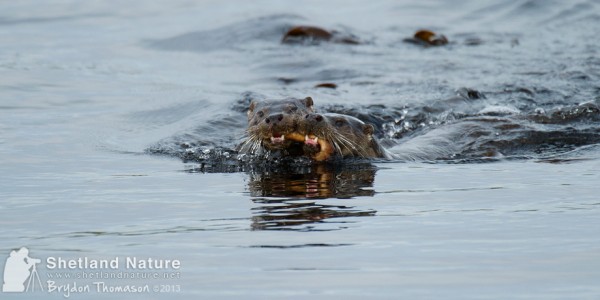
Permalink
Shetland Spring Birding May – June 2013
Posted by Martin Garner on Tuesday 9th July 2013 | Birding in Shetland, News
“Quick – grab your bags” was how the spring 2013 holiday began. No time for gentle introductions – a pod of Killer Whales had just been spotted off Sumburgh Head by Brydon, who was leading a photo-tour. Once disbelief had been quelled, it was all aboard the bus for the dash to try and see them! With a little help from friends and team effort, we got everyone up just in time- the week could not have got off to a better start! Our first seabirds such as Puffins, Guillemots and Razorbill offered a fine supporting cast. Pumped up with adrenaline, all guests were happy to press on for a couple of hours birding before dinner. We left the Orca pod to try to see a beautiful female Red-necked Phalarope at nearby Spiggie with a bathing ‘club’ of about 40 Great Skuas (Bonxies) as a backdrop. While watching the phalarope some of the group turned around only to find an Icterine Warbler on the fence-line; the first record of the spring for the isles (away from Fair Isles). Superb! We were already finding our own good birds. The 1st summer Ring-billed Gull was still present on Loch of Hillwell plus a host of fresh water birds and a Glaucous Gull. It’s fair to say the first couple of hours of this holiday had more than met expectations!
The next morning heralded our next ‘find’. A quick scan around Sumburgh farm revealed not one but 2 Red-backed Shrikes; a male recently present plus a new female with striking rich brown plumage. While watching the shrikes we also picked up Iceland Gull, Long-tailed Duck, Black Guillemot and Great Northern Diver.
Lerwick harbour was our mid-morning destination. A migrant male Pied Flycatcher in towns gardens proved birds can be found anywhere in Shetland but a Canada Goose at Clickimin Loch drew much more attantion. While the same size as 2 accompanying Canada’s, its darker, browner plumage with no white neck collar indicated its identity as a possible Todd’s Canada Goose – a vagrant bird form North America (and potential first for Shetland). Intrigued (and with sequence of images nailed) but somewhat distracted by our sailing time commitment for our boat trip to Noss, we only just made the pier in time for the spectacular trip on board the Dunter out to the seabird colony at Noss.
Another Glaucous Gull in the harbour plus summer plumaged Red-throated and Great Northern Divers bejewelled our journey.
Once there, the seabird cliffs provide a breath-taking spectacle yielding the kind of point blank views not usually possible with Gannets, Puffins, Razorbills and Guillemots plus lunch stealing Bonxies alongside the boat. Afternoon was spent taking spectacular scenery of east side of the South Ness including the tombolo at St Ninian’s Isle. We also found (another!) male Red-backed Shrike at Spiggie.
A rest around teatime prepared us for the late night outing to the magic of the Island of Mousa and the Storm Petrels. Famously described as the ‘sound of a fairy being sick’, the enchanting purring song of the petrels in the majestic and mysterious ancient broch created an unforgettable memory.
Bound for Unst we began Sunday morning with a Short-toed Lark on Sumburgh Head with awesome views of Puffins nearby. Britain’s most Northerly Island was a place of exploration and discovery for the next few days.
It was here on Unst that we had what was to stand out as one of the most favoured memories (among many) of the week’s holiday. So let’s fast forward:
Team effort is a key element for Shetland Nature holidays, both within our groups, amongst fellow team members and residents around the isles. Tuesday afternoon was the perfect example…. Unst resident Robbie Brookes contacted us to say he’d seen an acrocephalus Warbler at Skaw that he thought was probably a Marsh. We knew this was worth checking and arrived at Skaw to banks of mist rolling in on NE breeze; oow, special conditions indeed. We soon located a Garden Warbler, a Spotted Flycatcher and another bird ‘flew’ in’ to join them but remained obscured. With a little effort we were soon having great views of a spring Marsh Warbler and discussing the key ID features.
Just beyond up popped a female Red-backed Shrike. Fantastic! 2 minutes later another Red-backed Shrike, both on view at the same time.
Hold on – fog, north-east winds… now we’re cookin’. In the next half hour we found 6 Spotted Flycatchers and a Lesser Whitehroat. Then the icing on the cake: 2 of our guest returning from the beach said a couple of birds had been flitting about on the stream. Any bird that’s perhaps not familiar or appeared unusual is not to be left in Shetland and in these conditions…a quick stroll down and BOOM! a Little Bunting; regular but still a good find in autumn but very rare in spring. What a stunning bird and a life tick for most of the group.
Against this peak birding moment in Unst we savoured the majestic Hermaness with oodles of Bonxies, singing and displaying Dunlin and Golden Plover, another majestic seabird cliff, stunning spring Snow Buntings on Hermaness and Lamba Ness, Arctic Skuas and Arctic Terns.
Haroldswick scored for us too with migrant Wood Warbler, Greenland and Mealy Redpoll with a Quail in the same ‘ditch’, and the injured 1st summer Common Crane. Baltasound yielded migrants too including Long-eared Owl and Cuckoo and Otters on an early morning safari.
Our day trip to Fetlar always seems to produce something special. This time a Blyth’s Reed Warbler no less, found by SN team member Andy Cook – only the 7th May record for Britain! Redstart, Short-eared Owl and Siskin were all migrants and we found another Red-backed Shrike!
Like book ends, the last day of the holiday was marked by surprises which included rare birds and cetaceans. We got to be in on the identification wrestle with a typically and frustratingly elusive Thrush Nightingale at Virkie, another SN team member find, this time by Rob Fray and finished before dinner by finding 2 Minke Whales passing north off Sumburgh Head.
Space and words in a report like this make it impossible to shoehorn in, all of the wonderful experiences and discoveries we had. Suffice to say it was such a starlight holiday – we are already planning next spring’s gig, with a special guest guide Tim Appleton a ‘new addition’ to the Shetland Nature team.
And if you can’t wait that long, there are still places for this autumn birding holiday adventures!
Permalink
Shetland Autumn Seed Scheme
Posted by Brydon Thomason on Wednesday 6th February 2013 | Birding in Shetland, News
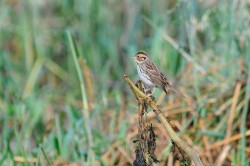
Little Bunting, Norwick, Unst. A typical species that is sure to find a crop in autumn in Shetland, and that birders hope to find, this Little cracker was one of two we found in one day with one of our autumn birding groups on a recent autumn trip.
Shetland has seen a massive change in crofting and agriculture over the past couple of decades. The ‘tattie’ and ‘oat crops’ which were once an iconic and authentic autumn scene throughout the crofting and inhabited landscapes are no longer a common sight. There are of course many land owners still planting crops traditionally but most now tend to be on a larger scale for machinery harvest and not the smaller scale once favoured so fondly by both birds and birders throughout the islands.
This year to encourage willing crofters and land owners, we have independently initiated a scheme to plant ‘sacrificial crops’ such as oats and mixed grain purposefully planted for birds, both resident and migrant and of course birders. Similar such scheme has run successfully for several years such as on on Fair Isle. We are delighted to already have several land owners on board on Unst and we hope that others (both birders and land owners) throughout the isles might do the same.
By helping work the land and part funding these crops we hope that as well as providing habitat for the birds it will also create new (as well as manage current) sites for local and visiting birders (as well as create habitat for our Shetland Autumn Birding guests to find our own birds) which is intended to help towards any potential issues with access, which should never be presumed at any site and permission should always be sought or guidelines understood. Further reading on ‘Birders Code of Conduct’ in Shetland can be found on the Nature in Shetland website.
Permalink
An eagle in the isles – a Norwegian White-Tailed Eagle in Shetland
Posted by Brydon Thomason on Friday 11th January 2013 | Birding in Shetland
Once a well-established native Shetland breeding species, White-Tailed Eagle (also known as Sea Eagle) is now a very rare sight in the isles. Persecution and the rapid colonisation of Fulmars, led to the extinction of the Erne (which was the Shetland for the species), over 100 years ago. The last of the native Shetland population was shot in the North Mainland in 1917. This bird, an albino, was not only the last of the local birds but also the last individual remaining from the entire Scottish population.
Reintroduction programmes have now been running in Scotland successfully for many years in the west of Scotland, particularly in the Western Isles. Birds that have been bred in Norway are released in Scotland, all of which are tagged or colour rung for monitoring and tracking purposes. More recently birds reintroduced to NE Scotland have been fitted with transmitters so there movements can also be recorded.
On the 13th December 2012 I had just returned home from dropping our oldest son Casey off at nursery and was just about to do some work in our garden when my attention was drawn to the alarm calls of Greater-Black Backed Gulls nearby. Such distress from the local gulls usually only means one thing – large raptor! Looking out across the Voe in Baltasound I picked them up with the naked eye; five Greater-Black Backs mobbing a ridiculously large and broad winged bird of prey – “Sea Eagle”, I shouted to myself!
What a beautiful sight it was drifting in the voe over Baltasound on that calm and crisp frosty winter’s morning. It flew in the Voe being mobbed by local Greater-Black Backed Gulls and Hooded Crows, which were all dwarfed by its sheer bulk and 8ft wing span.
Again on Unst on Boxing Day it drifted north towards Saxa Vord, giving us a privileged view. What was very interesting about this individual was that on both sightings it appeared not to be ‘wing tagged’. This led me to suspect it might well be a genuine vagrant from northern Europe.
Most records of immature birds reaching Shetland tend to be (or are at least presumed to be) of reintroduced individuals from Scottish schemes, however after another fabulous sighting of the Unst bird up on Valla Field on Unst on New Year’s Day, my suspicions were confirmed when we were able to, not only be sure it lacked wing tags but more importantly (and by Robbie Brooks capturing these fantastic photographs) record the colour ring combination.
I was delighted when after emailing the images to various sources for confirmation on its origin, coordinator of the colour ringing project for Northern Europe, Dr Bjorn Helander of The Swedish Museum for Natural History, replied within an hour almost as excited as I was with confirmation that it was indeed a Norwegian bird of authentic origin. The colour combination also concluded it was rung as a chick in 2011 but without the actual ring numbers, specifics such as ringing locality could not be concluded. These colour combination were used on the entire Norwegian coast.
This confirmation sparked quite further excitement from ornithologists from Northern Europe working on White-Tailed Eagles as I also received a reply back from Alv Ottar Folkestad, leader of the Norwegian Sea-eagle Project (Norwegian Ornithological Society), who was also very excited by the sighting, stating that this was the first ever confirmed record they had of one of ‘their birds’ crossing the North Sea. In Shetland however there is at least one confirmed sighting of a bird baring a Norwegian colour ring on right leg, details of which I have since found for him. Alv also pointed out the bird’s apparent reduced/delayed moult which he stated was unusual and probably sugested poor physical condition over the past year.
Any sighting of such a magnificent bird as a White-Tailed Eagle is sure to be exhilarating regardless of its origin or locality, but from a birders perspective to prove it to be ‘the real deal’ and a genuine vagrant ‘Sea Eagle’ and not one that had been introduced, was very exciting indeed.
It is interesting to know that a bird from the Scottish reintroduction scheme that visited Shetland was actually found to be breeding back on the Norwegian coast. Thanks to the reintroduction programmes, White-Tailed eagle is once again becoming a common sight in certain parts of Scotland and with the on-going work and support of the RSPB and others they will hopefully continue to be so. With the more recent stage of the programme being in NE Scotland it is quite likely that we may well see this supreme bird of prey more often in the isles.
Update: since these sightings above, presumably the same individual was seen on the 10th January drifting south over Skaw on Whalsay.
Permalink



